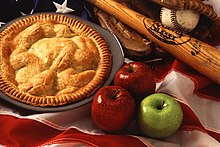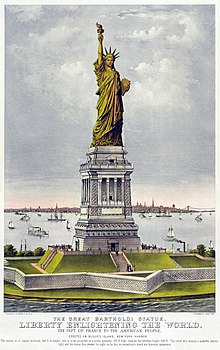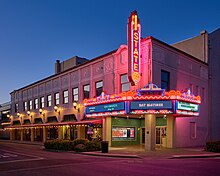

| This article is part of a series on the |
| Culture of the United States |
|---|
 |
| Society |
| Arts and literature |
| Other |
| Symbols |
|
United States portal |
Americana artifacts are related to the history, geography, folklore, and cultural heritage of the United States of America. Americana is any collection of materials and things concerning or characteristic of the United States or of the American people, and is representative or even stereotypical of American culture as a whole.
What is and is not considered Americana is heavily influenced by national identity, historical context, patriotism and nostalgia. The ethos or guiding beliefs or ideals which have come to characterize America, such as the American Dream, are central to the idea. Americana encompasses not only material objects but also people, places, concepts and historical eras which are popularly identified with American culture.
The name Americana also refers to Americana music, a genre of contemporary music that incorporates elements of various American music styles, including country, roots rock, folk, bluegrass, and blues, resulting in a distinctive roots-oriented sound.
As nostalgia
From the mid to late 20th century, Americana was largely conceptualized as a nostalgia for an idealized life in small towns and cities in the United States around the turn of the century, roughly in the period between 1880 and the First World War. It was believed that much of the structure of 20th-century American life and culture had been cemented in that time and place. American author Henry Seidel Canby wrote:
It is the small town, the small city, that is our heritage. We have made twentieth-century America from it, and some account of these communities as they were ... we owe our children and grandchildren.
Many kinds of cultural artifacts fall within the definition of Americana: the things involved need not be old, but are usually associated with some quintessential element of the American experience. Each period of United States history is reflected by the advertising and marketing of the time, and the various types of antiques, collectibles, memorabilia and vintage items from these time periods are typical of what is popularly considered Americana. The Atlantic described the term as "slang for the comforting, middle-class ephemera at your average antique store—things like needle-pointed pillows, Civil War daguerreotypes, and engraved silverware sets".
The nostalgia for this period was based on a remembrance of confidence in American life that had emerged during the period due to such factors as a sense that the frontier had finally been "conquered", with the U.S. Census Bureau's declaration that it was "closed" in 1890, as well as the recent victory in the Spanish–American War. By 1912, the contiguous United States was at last fully politically incorporated, and the idea of the nation as a single, solid unity could begin to take hold.
As Canby put it,
Americans at this time "really believed all they heard on the Fourth of July or read in school readers. They set on one plane of time, and that the present, the Declaration of Independence, the manifest destiny of America, the new plumbing, the growth of the factory system, the morning paper, and the church sociable. It was all there at once, better than elsewhere, their own, and permanent. ... They had just the country they wanted...and they believed it would be the same, except for more bathtubs and faster trains, forever ... for the last time in living memory everyone knew exactly what it meant to be an American."
On growing up Italian-American, novelist Don DeLillo stated:
It’s no accident that my first novel was called Americana. This was a private declaration of independence, a statement of my intention to use the whole picture, the whole culture. America was and is the immigrant's dream, and as the son of two immigrants I was attracted by the sense of possibility that had drawn my grandparents and parents.
— Conversations With Don DeLillo
The zeitgeist of this idealized period is captured in Disneyland and Magic Kingdom's Main Street, U.S.A. section (which was inspired by both Walt Disney's hometown of Marceline, Missouri and Harper Goff's childhood home of Fort Collins, Colorado), as well as the musical and movie The Music Man and Thornton Wilder's stage play Our Town. Especially revered in nostalgic Americana are small-town institutions like the barber shop, drug store, soda fountain and ice cream parlor; some of these were eventually resurrected by mid-twentieth century nostalgia for the time period in businesses like the Farrell's Ice Cream Parlour chain, with its 1890s theme.
Examples



Cultural symbols
- American football
- Baseball
- Blue jeans
- Clark Kent and Superman
- Cowboy
- Flag of the United States
- Fourth of July
- Hollywood
- Mount Rushmore
- Route 66
- Small town
- Statue of Liberty
- Tent revival
- Thanksgiving
- White picket fence
- Wild West
Food
- Apple pie
- Barbecue
- Bubble gum
- Brownies
- Buffalo wings
- Corn flakes
- Meatloaf
- Hamburgers
- Hot dogs
- Fried chicken
- Milkshake
- Muffins
- Pizza, american-style
Music
Religion
Clothing and fashion
- Blue jeans
- T-shirt
- Cowboy hat
- Motorcycle jacket
- Denim jacket
- Cowboy boots
- Penny loafer
- Workwear
- College prep
- Western shirt
Brand names
- Alden
- Allen Edmonds
- Budweiser
- Chevrolet
- Coca-Cola
- Ford
- Harley-Davidson
- Jack Daniel's
- JanSport
- Jim Beam
- Kellogg's
- Levi's
- Marlboro
- Nike
- Stetson
- Timberland
- Zero Halliburton
Similar concepts
- Regional
- Floridiana, artifacts relating to the state of Florida.
- Hawaiiana, Native Hawaiian cultural artifacts from Hawaii.
- Anglosphere
- Australiana, for cultural artifacts from Australia
- Canadiana, for cultural artifacts from Canada
- Kiwiana, for cultural artifacts from New Zealand
- Communist nostalgia, a similar concept in former or currently communist countries
- Ostalgie, a similar concept in East Germany
- PRL nostalgia, a similar concept in Poland
- Soviet nostalgia, a similar concept in the former Soviet Union
- Yugo-nostalgia, a similar concept in the former Yugoslav states
- Rhodesiana, a similar concept in Zimbabwe relating to items made when it was known as Rhodesia
See also
- American studies – Interdisciplinary academic field
- Black Americana – history museum in Big Rapids, MichiganPages displaying wikidata descriptions as a fallback
- Canadiana – Class of books of and about Canadian topics
- Culture of the United States
- Folklore of the United States
- History of the United States
- Romanticism#United States – Artistic, literary, musical, and intellectual movement
- Transcendentalism – 19th century US philosophical movement
References
- "Americana". Merriam-Webster.com Dictionary. Merriam-Webster.
- "Americana". Dictionary.com Unabridged (Online). n.d.
- Shriver, Jerry (August 31, 2009). "Grammys will be putting Americana on the map". USA Today.
- "2011 Grammy Category Descriptions" (PDF). Archived from the original (PDF) on January 3, 2015. Retrieved December 18, 2012.
- ^ Sears, Stephen (1975). Hometown U.S.A. New York: American Heritage. pp. 6–9. ISBN 0-671-22079-9.
- ^ Canby, Henry Seidel (1934). The Age of Confidence: Life in the Nineties. New York: Farrar & Rinehart. ASIN B000857UVO.
- Giovanni Russonello (August 2013). "Why Is a Music Genre Called 'Americana' So Overwhelmingly White and Male?". The Atlantic.
- DeLillo, Don (January 13, 2005). Conversations with Don DeLillo. University Press of Mississippi. p. 88. ISBN 1578067049.
- "Local History Archive Larimer Legends – Old Town & Disneyland – City of Fort Collins, Colorado". Library.ci.fort-collins.co.us. Archived from the original on January 25, 2009. Retrieved December 19, 2013.
- Sears, Stephen (1975). Hometown U.S.A. New York: American Heritage. pp. 12–13, 29. ISBN 0-671-22079-9.
- Sears, Stephen (1975). Hometown U.S.A. New York: American Heritage. pp. 12–13, 20. ISBN 0-671-22079-9.
- "Farrell's looks to restart growth Owner outlines expansion plans for iconic ice cream chain". Nation's Restaurant News. August 31, 2010. Retrieved June 4, 2014.
- ^ "What is Americana? (with pictures)". United States Now. August 28, 2023.
- ^ Evans, Jon (September 21, 2021). "Why "Baseball, Hot Dogs, Apple Pie And Chevrolet" Has Stood The Test Of Time". Advertising Weekly.
- ^ Perelman, Britton (August 27, 2020). "How to Capture "Americana" in Photography". Passion Passport.
- ^ Lineberry, Cate (March 1, 2007). "The Story Behind the Star Spangled Banner". Smithsonian Magazine.
- "Mount Rushmore Sculptor Gutzon Borglum Carved American History". Artistic Fuel. February 17, 2020.
- Sides, Hampton (2007). Americana: Dispatches from the New Frontier. Knopf Doubleday Publishing Group. ISBN 978-1400033553.
- ^ Stoutland, Frederick A. (2006). Landscapes of Christianity. FAS Publishing. p. 361. ISBN 9780977234103.
- Xiong, Nzong (March 3, 2008). "White picket fences appease homeowners". TuscaloosaNews.com. McClatchy-Tribune News Service. Archived from the original on September 2, 2015.
Americana aside, people like white picket fences for a couple of practical reasons.
- Warnes, Andrew (2008). Savage barbecue : race, culture, and the invention of America's first food. Athens, Ga.: University of Georgia Press. ISBN 9780820328966.
- O'Leary, Joanna. "The Jewish history of Bazooka bubble gum". www.timesofisrael.com.
- ^ Page, David (2021). Food Americana : the remarkable people and incredible stories behind America's favorite dishes. Coral Gables, FL. ISBN 9781642505863.
{{cite book}}: CS1 maint: location missing publisher (link) - "Behold the burger: Americana on a bun – DGO Magazine".
- McCarthy, Amy (June 29, 2022). "How Theme Parks Use Fried Chicken to Sell the American Dream". Eater.
- "Milkshakes: pure Americana and a Hong Kong burger's best friend". South China Morning Post. May 20, 2015.
- ^ Graham, David A. (May 17, 2016). "Without Jazz and Blues, There's No 'Americana'". The Atlantic.
- ^ "The Americana Essentials That Will Literally Never Go Out of Style | Complex". Complex Networks.
- Melvin, Don (October 7, 1990). "COCA-COLA A SIP OF AMERICANA THINGS HAVE BEEN GOING BETTER WITH COKE SINCE 1886". Sun-Sentinel.com.
- ^ Day, Sherri; Elliott, Stuart (January 10, 2003). "THE MEDIA BUSINESS: ADVERTISING; Coca-Cola goes back to its 'Real' past in an effort to find some new fizz for its Classic brand. - The New York Times". The New York Times.
Further reading
- Shaw, Robert (2023). Americana Insights 2023. University of Pennsylvania Press. ISBN 979-8-9885331-0-8.